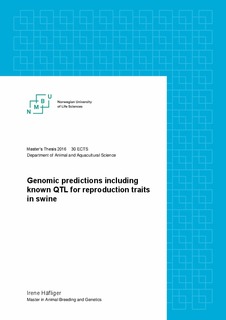| dc.description.abstract | Breeding values are the fundament on which the selection of the next generation is based on and should therefore be as reliable as possible. The implementation of marker-assisted selection (MAS), where major genes are included in the breeding value estimation (BVE), was the first method to use genomic information within the BVE. However, with the introduction of genomic selection (GS) it is possible to acknowledge the effects of several thousand markers. In this project, it is explored if the combination of these two genomic methods can improve the prediction accuracy of genomic best linear unbiased prediction (GBLUP). The study was carried out on the pig breed Swiss Large White. Used were deregressed breeding values of the reproduction traits number of piglets born alive (NBA), the proportion of underweighted piglets (UWP), the survival rate (PS), and the interval weaning to oestrus (IWO). Regarding the inclusion of additional markers, SNP panels in different extents were built based on markers that are known to be of importance from literature. Many QTLs were taken from the pig QTL database to build genomic relationship matrices, one with all QTL-markers (QTL-matrix) and one including only markers that were associated with reproduction traits (rQTL-matrix). They were added to the GBLUP model as additional random effect. Furthermore, few markers associated with the Escherichia Coli F4ab/ac (E.coli) resistance and the trait number of piglets born alive were added as fixed effects within GBLUP. A cross validation was performed based on the 400 youngest animals in the data set. Improvements of the likelihoods were observed, when an additional QTL-matrix was included. Significant changes were detected for the trait NBA, by including the rQTL-matrix and for the trait PS, by including the E.coli-resistance marker. The prediction accuracy was not improved by giving QTL-markers more weight within the GBLUP model for the data set used. Even thought, the method did not show any improvement of the prediction ability, the goodness-of-fit improved. In a more powerful data set, the improvements could even enhance the prediction accuracy. | nb_NO |

